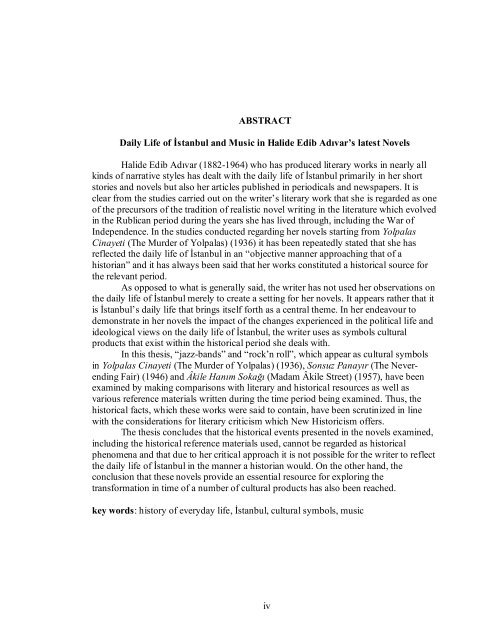Bilkent Üniversitesi Ekonomi ve Sosyal Bilimler ... - Bilkent University
Bilkent Üniversitesi Ekonomi ve Sosyal Bilimler ... - Bilkent University
Bilkent Üniversitesi Ekonomi ve Sosyal Bilimler ... - Bilkent University
You also want an ePaper? Increase the reach of your titles
YUMPU automatically turns print PDFs into web optimized ePapers that Google loves.
ABSTRACT<br />
Daily Life of İstanbul and Music in Halide Edib Adıvar’s latest No<strong>ve</strong>ls<br />
Halide Edib Adıvar (1882-1964) who has produced literary works in nearly all<br />
kinds of narrati<strong>ve</strong> styles has dealt with the daily life of İstanbul primarily in her short<br />
stories and no<strong>ve</strong>ls but also her articles published in periodicals and newspapers. It is<br />
clear from the studies carried out on the writer’s literary work that she is regarded as one<br />
of the precursors of the tradition of realistic no<strong>ve</strong>l writing in the literature which evol<strong>ve</strong>d<br />
in the Rublican period during the years she has li<strong>ve</strong>d through, including the War of<br />
Independence. In the studies conducted regarding her no<strong>ve</strong>ls starting from Yolpalas<br />
Cinayeti (The Murder of Yolpalas) (1936) it has been repeatedly stated that she has<br />
reflected the daily life of İstanbul in an “objecti<strong>ve</strong> manner approaching that of a<br />
historian” and it has always been said that her works constituted a historical source for<br />
the relevant period.<br />
As opposed to what is generally said, the writer has not used her observations on<br />
the daily life of İstanbul merely to create a setting for her no<strong>ve</strong>ls. It appears rather that it<br />
is İstanbul’s daily life that brings itself forth as a central theme. In her endeavour to<br />
demonstrate in her no<strong>ve</strong>ls the impact of the changes experienced in the political life and<br />
ideological views on the daily life of İstanbul, the writer uses as symbols cultural<br />
products that exist within the historical period she deals with.<br />
In this thesis, “jazz-bands” and “rock’n roll”, which appear as cultural symbols<br />
in Yolpalas Cinayeti (The Murder of Yolpalas) (1936), Sonsuz Panayır (The Ne<strong>ve</strong>rending<br />
Fair) (1946) and Âkile Hanım Sokağı (Madam Âkile Street) (1957), ha<strong>ve</strong> been<br />
examined by making comparisons with literary and historical resources as well as<br />
various reference materials written during the time period being examined. Thus, the<br />
historical facts, which these works were said to contain, ha<strong>ve</strong> been scrutinized in line<br />
with the considerations for literary criticism which New Historicism offers.<br />
The thesis concludes that the historical e<strong>ve</strong>nts presented in the no<strong>ve</strong>ls examined,<br />
including the historical reference materials used, cannot be regarded as historical<br />
phenomena and that due to her critical approach it is not possible for the writer to reflect<br />
the daily life of İstanbul in the manner a historian would. On the other hand, the<br />
conclusion that these no<strong>ve</strong>ls provide an essential resource for exploring the<br />
transformation in time of a number of cultural products has also been reached.<br />
key words: history of e<strong>ve</strong>ryday life, İstanbul, cultural symbols, music<br />
iv
















